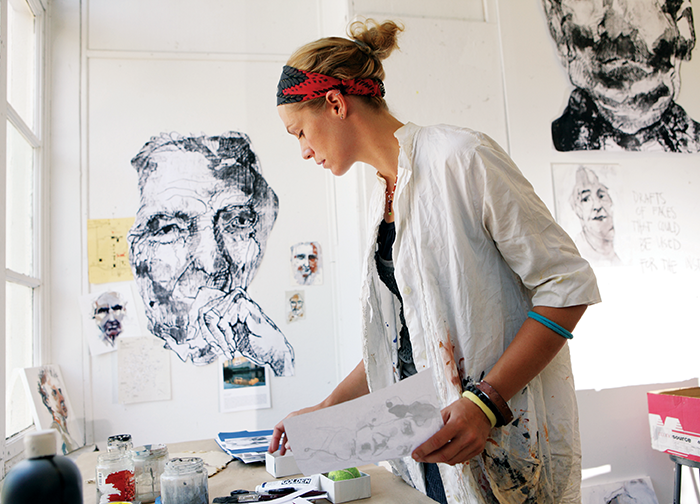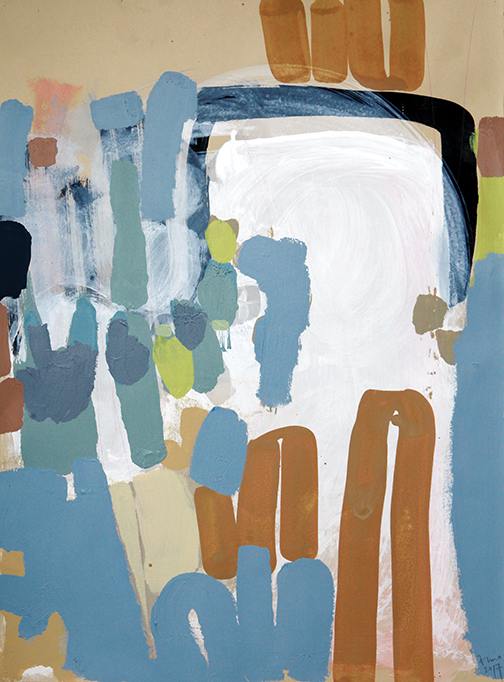Anna Schuleit Haber
Anna Schuleit Haber in her studio taken at UMCA, University Museum of Contemporary Art, UMass Amherst. Photo: John Solem.
Anna Schuleit Haber’s studio houses an archive of fruitful obsessions. A bright, high-ceilinged space in a converted textile mill in sleepy Harrisville, NH, the room hides neatly stored collections of sea-foam green paint chips, antique “magic lantern” slides, pulleys, plates and vintage tools. Schuleit Haber dwells in possibility.
Schuleit Haber works at the juncture of painting, drawing, performance, installation art, architecture and community. Her works have ranged from multimedia paintings to large-scale projects in forests, on uninhabited islands, and in psychiatric institutions, using extensive sound systems, live sod, thousands of flowers, antique telephones, bodies of water and neuroscience technologies.
Though first and always a painter, how would it be, she once wondered, if the abandoned mental hospital she frequented as a teenager could be reborn, just once, as a musical instrument?
Born in Germany to a family of artists, she came to the U.S. at 16 to attend boarding school not far from Northampton State Hospital, then a wistful ruin. It opened in 1855 on the belief that beautiful environments would help “stabilize the mind.” But over decades of crowding and too little funding, it warehoused anyone society couldn’t care for. It was shuttered in 1993.
As a student at RISD, Schuleit Haber returned to paint the architecture of the abandoned institution. Photographs were prohibited, so she sketched matchbox-sized miniatures she could hide in her coat sleeve.
Anna Schuleit Haber, 035 Comedy, signed on front, mixed media on paper, framed, 343⁄4 x 27″, (ASH020). © The Artist. Courtesy of Abigail Ogilvy Gallery.
She eventually obtained permission to enter the hospital to paint, draw and take pictures (she ended up with 60,000 of them). The texture of the paint flaking off the walls and how the building was being taken over by nature—“the tenderness in that”—fascinated her. She thought of music she sang in choir as a girl, including J.S. Bach’s Magnificat. She saw beauty in the flow from room to room of the many shades of “tranquil blue-greens” and began collecting shards of the paint. With these she built an assemblage that became her RISD senior thesis project.
Later, making artists’ books and working part-time jobs in New York City, she found herself wondering what it would be like to really fill the hollows of that abandoned space with Bach’s sacred choral music. She sent a proposal to the MacDowell Colony and was granted a fellowship to pursue the idea. It took four years of single-minded, mostly unfunded groundwork to make it happen. The final project took on a public dimension Schuleit Haber hadn’t fully considered. To her, the piece was for the building, an act of imagination that demanded she make it. But in the end 1,000, people experienced Habeas Corpus, her two-day installation in 2000. People stood and walked around the condemned buildings, many awed or shedding tears, as the old “insane asylum” resounded “like a violin or a cello” for 28 minutes with Bach’s glorious cycle of sacred canticles streaming from the hundreds of opened windows.
Shortly thereafter, the still-operating 600-acre Worcester County Westborough State Hospital called and offered a residency. The next three years of sketching, gathering patients’ stories and taking photographs led Schuleit Haber to undertake a master’s in creative writing at Dartmouth. Music and narrative, the written and the evoked, intertwine with her practice.
Each project feels to her like a “creative gift” that must be given to the subject of the work. Habeas Corpus was for the building itself and
its many ghosts. Fighting for a vision, without
a roadmap or funding, you have to “assume that you are going to lose it all,” she told me. “Close your eyes and trust that it will be okay.”
While she was at Westborough, a Harvard professor called from Massachusetts Mental Health Center. He asked if she could do the same thing for them that she’d done for Northampton. Spending a week on-site, she noticed the steady flow of people at the hospital across the street, many carrying colorful bouquets for convalescents. She thought about the patients at Westborough, how during her entire residence, not a single one received a visitor, let alone flowers. She took audio recordings of the building and imagined everything on all three floors just as the final patients, doctors and staff had left it flowing with bright, living fields of color. She titled it Bloom. Not long after, she received a MacArthur Foundation “genius” grant for Habeas Corpus and Bloom.
BLOOM, installation of 28,000 live flowers at the Massachusetts Mental Health Center, commissioned by Harvard University Department of Psychiatry and the Department of Mental Health of Massachusetts, November 2003. All of the flowers were potted, not cut, and later donated and delivered to psychiatric hospitals, shelters and halfway houses. Courtesy of the artist.
Schuleit Haber seems to flourish when quixotically championing one or more enormous multitiered projects, often involving dozens of people in multiple locations making something unprecedented happen against near-impossible odds. You must “give it all,” she says. “There’s a reward for running at full risk.” And yet, this isn’t the artistic life she envisioned. Schuleit Haber considers painting her foundation. And given the primary role that color played in Bloom and paint played in Habeas, for example, it seems her interventions emerge from her embrace of the joys and frustrations of painting.
“I think through paint,” she says. “I adore mixing wet things and moving them around, applying them to surfaces, watching them dry, beginning to correspond to other marks, colors, fields. I think that I really cannot create other more cerebral works if I don’t paint.”
She and her husband, Yotam Haber, began collaborating on a long-term project shortly after they met and discovered a mutual fascination with Austrian writer Thomas Bernhard’s collection of absurdist political flash fiction stories, The Voice Imitator. This winter, she showed work from the series at Abigail Ogilvy Gallery in Boston as well as in New York, Hong Kong and London. Eventually there will be 104 paintings and 104 corresponding solo piano compositions by her husband, one for each story in the book.
Anna Schuleit Haber, 046 Guilty Conscience, signed on front, mixed media on paper, framed, 343⁄4 x 27″, (ASH023). © The Artist. Courtesy of Abigail Ogilvy Gallery.
The paintings, executed on raw linen or paper with pencil, charcoal, ink, oil pastels, and opaque and translucent oil and acrylic paint, are energized fields of painterly gestures. Their dynamic assembly of calligraphic marks (she sometimes uses up to 200 brushes on a single painting) invoke fragmented, deconstructed narrative spaces that hint at figures and objects that seem to surface and recede as the paintings lean into abstraction.
In embracing “full risk,“ Schuleit Haber bests one of the characters in The Voice Imitator, a famous dancer who realizes that, to perform the improbable, a dancer has only “never to think about his dance while he is dancing.”
Christopher Volpe is a New Hampshire–based artist and teacher.
Anna Schuleit Haber




